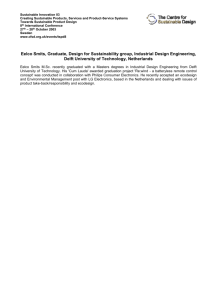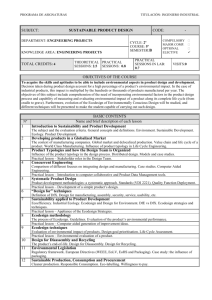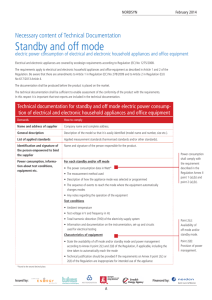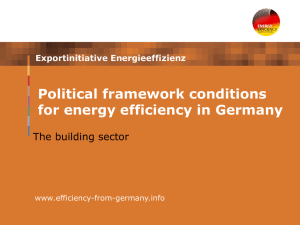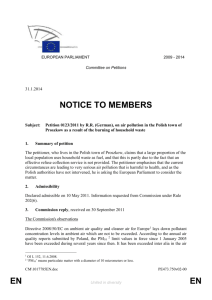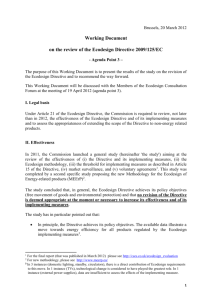Aalborg University
advertisement
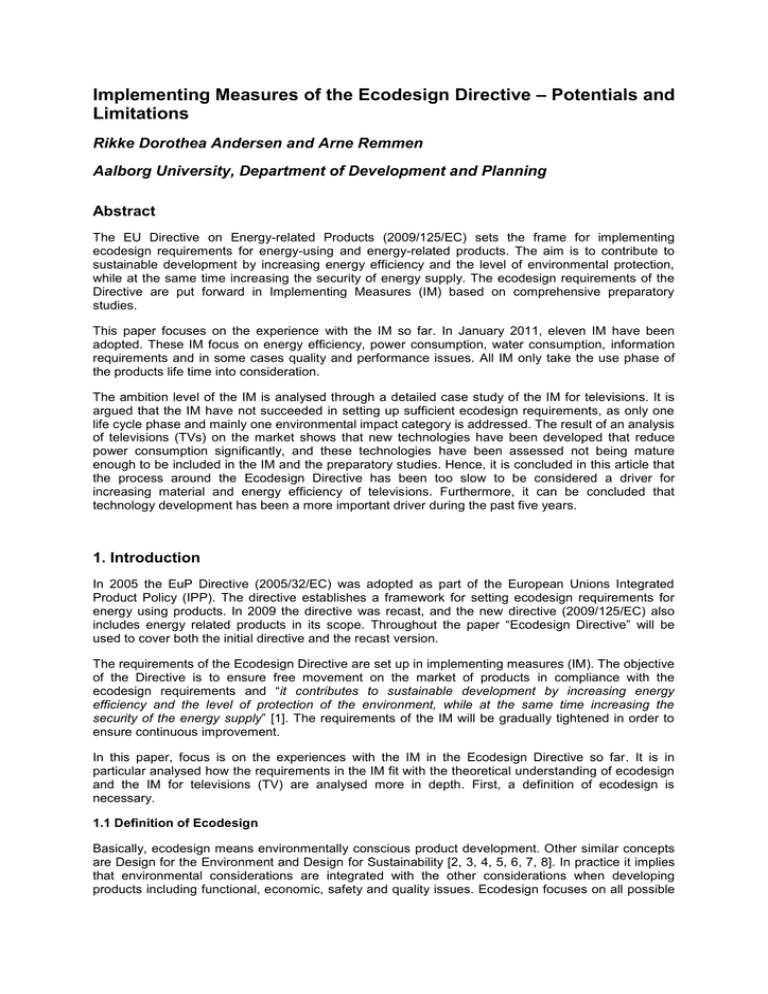
Implementing Measures of the Ecodesign Directive – Potentials and Limitations Rikke Dorothea Andersen and Arne Remmen Aalborg University, Department of Development and Planning Abstract The EU Directive on Energy-related Products (2009/125/EC) sets the frame for implementing ecodesign requirements for energy-using and energy-related products. The aim is to contribute to sustainable development by increasing energy efficiency and the level of environmental protection, while at the same time increasing the security of energy supply. The ecodesign requirements of the Directive are put forward in Implementing Measures (IM) based on comprehensive preparatory studies. This paper focuses on the experience with the IM so far. In January 2011, eleven IM have been adopted. These IM focus on energy efficiency, power consumption, water consumption, information requirements and in some cases quality and performance issues. All IM only take the use phase of the products life time into consideration. The ambition level of the IM is analysed through a detailed case study of the IM for televisions. It is argued that the IM have not succeeded in setting up sufficient ecodesign requirements, as only one life cycle phase and mainly one environmental impact category is addressed. The result of an analysis of televisions (TVs) on the market shows that new technologies have been developed that reduce power consumption significantly, and these technologies have been assessed not being mature enough to be included in the IM and the preparatory studies. Hence, it is concluded in this article that the process around the Ecodesign Directive has been too slow to be considered a driver for increasing material and energy efficiency of televisions. Furthermore, it can be concluded that technology development has been a more important driver during the past five years. 1. Introduction In 2005 the EuP Directive (2005/32/EC) was adopted as part of the European Unions Integrated Product Policy (IPP). The directive establishes a framework for setting ecodesign requirements for energy using products. In 2009 the directive was recast, and the new directive (2009/125/EC) also includes energy related products in its scope. Throughout the paper “Ecodesign Directive” will be used to cover both the initial directive and the recast version. The requirements of the Ecodesign Directive are set up in implementing measures (IM). The objective of the Directive is to ensure free movement on the market of products in compliance with the ecodesign requirements and “it contributes to sustainable development by increasing energy efficiency and the level of protection of the environment, while at the same time increasing the security of the energy supply” [1]. The requirements of the IM will be gradually tightened in order to ensure continuous improvement. In this paper, focus is on the experiences with the IM in the Ecodesign Directive so far. It is in particular analysed how the requirements in the IM fit with the theoretical understanding of ecodesign and the IM for televisions (TV) are analysed more in depth. First, a definition of ecodesign is necessary. 1.1 Definition of Ecodesign Basically, ecodesign means environmentally conscious product development. Other similar concepts are Design for the Environment and Design for Sustainability [2, 3, 4, 5, 6, 7, 8]. In practice it implies that environmental considerations are integrated with the other considerations when developing products including functional, economic, safety and quality issues. Ecodesign focuses on all possible areas of improvements in the product’s entire life cycle, from the definition of the function, over selection of raw materials, production methods and transport means, to how the use, recycling and disposal are organised. All relevant environmental properties should be addressed, including material and energy efficiency, emissions and hazardous substances. The aim of ecodesign is to fulfil a need with the least environmental impact, meaning that the function of the product should be the point of departure for future product development [2]. Figure 1 illustrates an ecodesign strategy wheel, developed by Han Brezet and Carolien van Hemel in 1997. The strategy wheel illustrates the steps and strategies that can be followed in ecodesign. The centre of the figure is a spider web illustrating the environmental profile of the product. In this case the blue area illustrates the environmental profile of the old product and the green area illustrates the profile of the new and ecodesigned product. In the following the adopted IM of the Ecodesign Directive are analysed. In this analysis, we focus on all the life cycle phases and environmental impacts included in the IM. Hereafter, an in depth case study of the IM for televisions (TV) is presented. The focus areas of the IM are compared to the criteria of four ecolabels; the European Ecolabel, the Nordic Ecolabel, Energy Star and TCO’06 for Media Displays. The aim is to investigate which other environmental areas are assessed important by other instruments. The rationale is twofold; first of all, ecolabels are acknowledged by authorities, consumers and producers. Secondly, many years of experience and work are behind the ecolabels. The products fulfilling the criteria of eco-labels are considered among the best environmentally performing product in their category without compromising the quality. All ecolabels except the Energy Star consider the entire life cycle of the product. Consequently, they are in line with the definition of ecodesign. Finally, the performance of TVs on market are investigated and compared to the requirements in the IM. 2. Methods The study is based on a literature review of the Ecodesign Directive, the IM for TV and four ecolabels; The European Ecolabel, The Nordic Ecolabel, Energy Star and TCO’06 [9, 10, 11, 12]. Information concerning the performance of TVs on the market has been gathered on the webpages of the producers. The TVs analysed are considered being the best available technology. TVs from the following brands were analysed: Samsung [13, 14, 15] Sony [16, 17] Philips [18] 3. Implementation of the Ecodesign Directive The status in January 2011 is that eleven IM have been adopted. The first entered into force in January 2009. In Table 1 the focus areas of the eleven IM are listed. It is visible that all IM include either power consumption or energy efficiency in the requirements. The only exception is the IM for electric motors. This IM has a focus on motor efficiency which is also energy related. Five of the eleven IM focus solely on power consumption and/or energy efficiency, which is a high percentage of the IM. Other areas addressed by some of the IM are related to quality and performance issues. The only IM that stands out to some degree is the IM for washing machines, which has included requirements on water consumption in the IM. It is also noteworthy that all requirements are concerned about the use phase only. Three conclusions can be drawn from this analysis: 1. Not all environmental areas are addressed in the IM, which is in contradiction with the concept of ecodesign as defined above, as all environmental areas should be addressed according to ecodesign. 2 2. Only one life cycle phase is addressed, which also is in contradiction with the concept of ecodesign, as all life cycle phases should be addressed according to ecodesign. 3. The requirements are in line with the concept of ecodesign when it comes to continuous improvement. As noted above the requirements are gradually tightened to achieve innovation. According to Article 15, 4. (a) of the Directive the Commission shall, when preparing a draft for IM, “consider the life cycle of the product and all its significant environmental aspects, inter alia, energy efficiency.” It is in this article assessed that the narrow focus of the IM for TVs is a result of a too narrow interpretation of article 15, 4. (a) and hence only the most important environmental aspect is included in the IM. It can therefore be concluded that the Ecodesign Directive has the potential to regulate more environmental impacts of the products if not only the most important areas are addressed. In the following, four ecolabels are analysed with the aim of analysing which other environmental areas are assessed relevant to regulate by other instruments. 4. Implementing Measures for Televisions compared to Ecolabels In this section the IM for TVs is analysed more in depth. According to the Danish Energy Agency the number of TVs in Danish households has grown rapidly in recent years from around 2.2 million in 1980 to 5.5 million in 2008 [31]. That equals a growth from approximately 1 TV per household in 1980 to around one per person in 2008. This rapid growth underlines the importance of investigating the environmental impact of TVs and set up requirements for TVs. The focus areas of the IM for TVs and the ecolabels for TVs are compared in Table 2. The narrow focus of the IM for TVs is very clear in this comparison. All ecolabels except the Energy Star focus on general ecodesign criteria, dismantling, lifetime extension and chemicals, thereby setting criteria to several phases of the products’ life cycle and to more environmental areas. Taking a closer look at the energy criteria on on-mode power consumption, it is evident that the requirements of the IM are not as strict as the ecolabels, see Figure 2. The IM requirements for full HD are for example 1.7 times larger than the European Ecolabel criteria for 2009. The IM requirements for 2012 are more than 1.5 times larger than the European Ecolabel criteria for 2011. This is not surprising as they are different types of policy instruments. Ecolabels are meant as an incentive for frontrunner companies, whereas the IM are minimum requirements aiming at excluding the worst performing products from the market. However, the range between the two requirements, especially with the larger screen sizes, is quite big. Furthermore, the IM requirements do not set an upper limit for maximum on-mode power consumption, thereby accepting the connection between screen size and power consumption. This is problematic since there is a trend towards bigger and bigger screens, with most likely higher power consumption. Both the Nordic and the European ecolabels have considered this and set a maximum on-mode power consumption of 200 Watt regardless of screen size. 5. Performance of Televisions on the Market compared to the Implementing Measures In this section, the on-mode power consumption of televisions on the market is analysed and compared to the requirements of the IM. The aim is to assess the ambition level of the IM. The study was done in the winter of 2009/10 and again in winter/spring 2011. As the requirements entered into force in summer 2010, the study is performed half a year before and after the requirements entered into force. TVs with ecolabels were first analysed in the study in 2009/10. These were regarded as the best available technologies (BAT). Two technologies have a significant positive influence on the environmental impact of TVs; Light Emitting Diodes (LED), used by Samsung, and Hot Cathode Fluorescent Lamp (HCFL), used by Sony. Besides this technology, Sony has installed a number of features that helps reduce the power consumption even further. These are a presence sensor that 3 detects movement and body heat, and a light censor, which registers the light in the room and adjust the backlight of the TV accordingly. All investigated TVs based on the new technologies are labelled with the European or the Nordic Ecolabel. For the study in 2011 it was found that the ecolabelled TVs were not necessarily the most energy efficient TVs. Therefore, the TVs with the lowest on-mode power consumption are presented in Figure 2, regardless if they are labelled with an ecolabel or not. The ecolabelled TVs in the study from 2011 are Samsung 32” and 40”, Philips 42” and 46”. These are all labelled with the European Ecolabel. Figure 2 illustrates the power consumption of ecolabelled TVs from Samsung, Sony and Philips. It is obvious that the TVs based on these new technologies perform better than what is required by the IM, some of the TVs even comply with the Energy Star criteria of 2012, which are the strictest criteria. Since this study was made twice with a year in between Figure 2 also illustrates the development of the power consumption within this year. It is noticeable that in 2009/10 BAT was considered to be ecolabelled TVs. However, in 2011 in several cases for Sony TV the best performing TVs, in terms of power consumption, were not the ones labelled with an ecolabel. This is an interesting result as it could lead to the conclusion that not even the ecolabels can keep up the pace of the technological development A new technological development in the time between the two studies is the 3D technology. All TVs from Samsung in 2011 have included the 3D technology. As it is illustrated in Figure 2 even the TVs with the new technology are also easily able to comply with the requirements of the IM. A positive development is the 42” TV from Philips, which nearly consumes half the power compared to some of the TVs with a smaller screen size. This TV is also based on the LED technology and has installed different power saving features such as a light sensor and eco mode [18]. Philips TVs were not part of the 2009/10 investigation, consequently a comparison with the older models of Philips is not possible. In the preparatory studies of the IM the LED technology was mentioned. The consultancy who prepared the preparatory study did however, not find the technology mature enough to be able to draw conclusions on its power consumption level and its environmental impact [28]. It can therefore be assumed that the technology has not had a significant impact on the requirement setting process. This is not a surprise though, as the LED technology was not on the market, when the preparatory studies began. The question is therefore why the technological development in the case of LED has happened so rapidly. Possibly, the industry did develop the technology faster as an attempt to anticipate the coming IM of the Ecodesign Directive or the development would have happened regardless of the adoption of the Ecodesign Directive. The 3D technology has not been mentioned at all in the preparatory study. In both cases the attention is drawn to the time span from the preparatory study, where the analyses are made on possible requirements of the IM and to the time when the requirements step into force. The process is quite complex and long with involvement of all stakeholders, and the technologies in the TVs can develop significantly faster than what is expected in the IM. 6. Conclusions In this paper the IM of the Ecodesign Directive are analysed. In particular how the requirements in the IM fit with the theoretical understanding of ecodesign and how ambitious the requirements are compared to ecolabels and the performance of best available TVs on the market. The status in January 2011 is that eleven IM have been adopted. Many of the IM have a focus on power consumption or energy efficiency only. Other issues regulated are related to water consumption, performance and quality. A strong tendency is found that only the use phase of the products is included. Compared to the theoretical understanding of ecodesign, three conclusions can be drawn: 1. Not all environmental areas are addressed in the IM, which is in contradiction with the concept of ecodesign as defined above, and by the way, also to the scope of the Directive. 2. Only one life cycle phase is addressed, which also contradict with the concept of ecodesign, as all life cycle phases should be addressed. 4 3. The requirements are in line with the concept of ecodesign when it comes to continuous improvement. As noted, the requirements are gradually tightened to achieve improvements of performance over time. The comparison of the IM and the European Ecolabel, the Nordic Ecolabel, Energy Star and TCO’06 shows that the ecolabels are significantly stricter than the IM – as they should be – and they include more environmental areas and product life cycle phases in their criteria. One reason for the narrower scope is that the IM only focus on the most important environmental impact. However, in order for the directive to be in line with the concept of ecodesign it is an imperative that more environmental impacts and life cycle phases are considered. With regard to the IM being less strict than the ecolabels, this is not surprising as they are different types of policy instruments. Ecolabels are meant as an incentive for frontrunner companies, whereas the IM are minimum requirements aiming at excluding the worst performing products from the market. However, there is a large range between the two requirements, especially with regard to the larger screen sizes. First, the IM simply accept the relation between the screen size and power consumption. The European and the Nordic Ecolabel have dealt with this by setting an upper limit of 200 Watts regardless of screen size. Further, looking at the market tendency towards larger screen sizes and at the performance of the best available TVs these can easily comply with the IM and many of the ecolabels. This raises the question: what impact does the IM have at all if the performance of the TVs is way below the requirements? The study of the TVs on the market shows that all investigated TVs could comply with the requirements of the IM and many of the ecolabels both in 2009/10 and in 2011. As only TVs including BAT are analysed this result is not a surprise. However, it is surprising how low the power consumption is. The TV producers have applied different technologies to obtain these low power consumption values. Samsung and Philips have used LED as backlight, which was assessed to be an immature technology in the preparatory study. This leads to the conclusion that the environmental improvements of TVs seem to be driven by a technology push rather than a regulatory pull. It could though also be the case that the producers have speeded up the development of the LED technology because of future requirements in the IM – future expectations to regulatory demands as a driver. A new technology applied in 2011 is the 3D TV. Even the TVs with the new technology are still easily able to comply with the requirements of the IM. The 3D technology has not been mentioned at all in the preparatory study. In both cases, a conclusion is that the process of Ecodesign Directive and the IM takes too long in the case of televisions, and furthermore the innovation of new televisions is more driven by technology push rather than regulatory pull leading to an improved environmental performance. Since this study was made twice with a year in between it is also possible to see the development within this year. It is noticeable that in 2009/10 BAT was considered to be ecolabelled TVs. However, in 2011 in several cases for Sony TVs, the best performing TVs in terms of power consumption were not the ones labelled with an ecolabel. This is an interesting result as it could lead to the conclusion that not even the ecolabels can keep up the pace of the technological development. 5 0) New concept development Dematerialising Shared use of the product Integration of functions From products to service 7) Optimisation of end-of-life system Reuse of the product Remanufacturing Recycling of materials Cleaner waste incineration 6) Optimisation of product life Reliability and durability Easier maintenance and repair Modular product structure Classic design Strong product-user relation - + 2) Reduction of materials Reduction in weight Reduction in volume (transport) 3) Optimisation of production technology Use of cleaner technology Fewer production steps Lower and cleaner energy consumption Less production waste 5) Reduction of impact during use Lower energy consumption Cleaner energy source Fewer consumables needed No waste of energy/consumables Old product 1) Selection of low-impact materials Fewer environmentally harmful materials Renewable materials Materials with low energy content Recycled materials Recyclable materials 4) Optimisation of distribution systems Less/cleaner/reusable packaging Energy efficient transport forms Energy efficient logistics New product Figure 1: The ecodesign strategy wheel [4]. 6 400 Power consumption in Watt 350 300 250 200 150 130 100 100 88 79 60 85 57 50 108 105 98 86 58.1 0 20 23 26 32 37 40 42 46 50 Screen size in inches ErP Directive Full HD 2010 ErP Directive other resolutions 2010 ErP Directive all 2012 European 2009 and Nordic Ecolabel European Ecolabel 2011 European Ecolabel 2013 Energy Star 2010 Energy Star 2012 Samsung 2009/10 Sony Bravia 2009/2010 Samsung 2011 Sony Bravia 2011 Philips 2011 Figure 2: On-mode power consumption requirements of the IM and the ecolabels for TVs and the power consumption of Samsung, Sony and Philips TVs with the BAT [9, 10, 11, 12, 13, 14, 15, 16, 17, 18, 19]. Television 12.08.09 22.07.09 Standby and offmode losses 07.01.09 17.12.08 Battery chargers and external power supplies 27.04.09 07.04.09 Tertiary lighting 13.04.09 18.03.09 Simple set-top boxes 25.02.09 04.02.09 Information requirements Washing cycle at 20° Water consumption Washing efficiency Drying efficiency Cleaning efficiency Motor efficiency Performance Lamp efficacy Energy efficiency Power consumption Adopted Entry into force Table 1: Focus area of the eleven adopted IM of the Ecodesign Directive [19, 20, 21, 22, 23, 24, 25, 26, 27, 29, 30]. 7 Domestic lighting 18.03.09 14.04.09 Electric motors 12.08.09 22.07.09 Circulators 12.08.09 22.07.09 Domestic refrigeration 12.08.09 22.07.09 Domestic dishwashers 01.12.10 10.11.10 Domestic washing machines 01.12.10 10.11.10 Table 2: Focus area of the IM for TVs and the ecolabels for TVs [9, 10, 11, 12, 19] Subject Implementing Measures European Ecolabel Nordic Ecolabel Energy Star TCO'06 Power consumption on-mode Power consumption in off-mode Power consumption in passive standby Power consumption active standby low Maximum energy consumption General eco-design criteria Dismantling Life-time extension Chemicals in products Information requirements Environmental Management system 8 References [1] European Commission. “Directive 2009/125/EC of the European Parliament and of the Council of 21 October 2009 establishing a framework for the setting of ecodesign requirements for energy-related products”, Official Journal of the European Union, October 31, 2009. [2] Tischner, U. Sustainable Design and Ecodesign, Design Academy Eindhoven, Eindhoven, 2006. [3] Tischner, U., E. Schmincke, F. Rubik and M. Prösler. How to do EcoDesign? Verlag form GmgH, Frankfurt am Main, 2000. ISBN 3-89802-025-8 [4] H. Brezet and C. van Hemel. Ecodesign – A promising approach to sustainable production and consumption. United Nations Environment Programme (UNEP), Paris, 1997. ISBN 92-8071631-X [5] I. Zbicinski, J. Stavenuiter, B. Kozlowska and H. van de Coevering. Product Design and Life Cycle Assessment. The Baltic University Press, Uppsala, 2006. ISBN 91-975526-2-3 [6] F. Giudice, G. La Rosa and A. Risitano. Product Design for the Environment - A Life Cycle Approach. CRC Press, Taylor and Francis Group, Boca Raton, 2006. ISBN 0-8493-2722-9 [7] M. Charter and U. Tischner (eds.). Sustainable Solutions – Developing Products and Services for the Future. Greenleaf Publishing, Sheffield, 2001. ISBN 1-874719-36-5 [8] L. Kørnøv, M. Thrane, A. Remmen and H. Lund (eds.). Tools for Sustainable Development. Aalborg Universitetsforlag, Aalborg, 2007. ISBN 978-877307797-9 [9] European Commission. “Commission Decision of 12 March 2009 establishing the revised criteria for the award of the Community Eco-label to televisions”. Official Journal of the European Union, March 28, 2009. [10] Nordic Ecolabelling. Nordic Ecolabelling of Audiovisual equipment: Version 3.0 – 17 March 2009 – 31 December 2010. Nordic Ecolabelling, 2009. [11] Energy Star. Energy Star Program requirements for Televisions: partner Commitments Versions 4.0 and 5.5. Energy Star, 2009. [12] J. Rudling, and H. Nordin. TCO’06 Media Displays: Ver. 1.2. TCO Development, Sweden. 2006. [13] Samsung Electronics Nordic AB. This changes everything LED TV: Velkommen til en ny verden. http://www.emagin.se/v5/viewer/files/viewer.aspx?gIssue=1&gTitle=LED%20Catalogue%20DK&gYear=200 9&gUserID=0&gPaperID=30385&gAvailWidth=1014&gAvailHeight=733&gInitPage=1 (accessed November 10, 2009). [14] Samsung. http://www.samsung.com/dk/. 2010 (accessed February 5 2010). [15] Samsung. 2011. http://www.samsung.com/dk/index.html (accessed May 5, 2011) [16] Sony. Http://www.sony.dk/section/startside. 2010 (accessed February 5, 2010) [17] Sony. http://www.sony.dk/section/startside 2011. (accessed January 12, 2011) [18] Philips. Sense and Simplicity. 2011. http://www.philips.dk/index.page (accessed January 12, 2011) [19] European Commission. “Commission Regulation (EC No 642/2009 of 22 July 2009 implementing Directive 2005/32/EC of the European Parliament and the Council with regard to ecodesign requirements for televisions”. Official Journal of the European Union, July 23, 2009. 9 [20] European Commission. “Commission Regulation (EC) No 1275/2008 of 17 December 2008 implementing Directive 2005/32/EC of the European Parliament and of the Council with regard to ecodesign requirements for standby and off mode electric power consumption of electrical and electronic household and office equipment”. Official Journal of the European Union, December 18, 2008. [21] European Commission. “Commission Regulation (EC) No 278/2009 of 6 April 2009 implementing Directive 2005/32/EC of the European Parliament and of the Council with regard to ecodesign requirements for no-load condition electric power consumption and average active efficiency of external power supplies”. Official Journal of the European Union, April 7, 2009. [22] European Commission. “Commission Regulation (EC) No 245/2009 of 18 March 2009 implementing Directive 2005/32/EC of the European Parliament and of the Council with regard to ecodesign requirements for fluorescent lamps without integrated ballast, for high intensity discharge lamps, and for ballasts and luminaries able to operate such lamps, and repealing Directive 2000/55/EC of the European Parliament and of the Council”. Official Journal of the European Union, March 24, 2009. [23] European Commission. “Commission Regulation (EC) No 107/2009 of 4 February 2009 implementing Directive 2005/32/EC of the European Parliament and of the Council with regard to ecodesign requirements for simple set-top boxes”. Official Journal of the European Union, February 5, 2009. [24] European Commission. “Commission Regulation (EC) No 244/2009 of 18 March 2009 implementing Directive 2005/32/EC of the European Parliament and of the Council with regard to ecodesign requirements for non-directional household lamps”. Official Journal of the European Union, March 24, 2009. [25] European Commission. “Commission Regulation (EC) No 640/2009 of 22 July 2009 implementing Directive 2005/32/EC of the European Parliament and of the Council with regard to ecodesign requirements for electric motors”. Official Journal of the European Union, July 23, 2009. [26] European Commission. “Commission Regulation (EC) No 641/2009 of 22 July 2009 implementing Directive 2005/32/EC of the European Parliament and of the Council with regard to ecodesign requirements for glandless standalone circulators and glandless circulators integrated in products”. Official Journal of the European Union, July 23, 2009. [27] European Commission. “Commission Regulation (EC) No 643/2009 of 22 July 2009 implementing Directive 2005/32/EC of the European Parliament and of the Council with regard to ecodesign requirements for household refrigerating appliances”. Official Journal of the European Union, July 23, 2009. [28] Stobbe, Dr. Lutz. EuP Preparatory Studies “Televisions” (Lot 5): Final Report on Task 6 “Technical Analysis BAT”. Compiled by Fraunhofer IZM, Berlin. 2007. [29] European Commission. “Commission Regulation (EU) No 1015/2010 of 10 November 2010 implementing Directive 2005/32/EC of the European Parliament and of the Council with regard to ecodesign requirements for household washing machines”. Official Journal of the European Union, November 11, 2010. [30] European Commission. “Commission Regulation (EU) No 1016/2010 of 10 November 2010 implementing Directive 2005/32/EC of the European Parliament and of the Council with regard to ecodesign requirements for household dishwashers”. Official Journal of the European Union, November 11, 2010. [31] Danish Energy Agency. “Energistatistik 2008”. http://www.ens.dk/daDK/Info/TalOgKort/Statistik_og_noegletal/Aarsstatistik/Sider/Forside.aspx. 2010. (accessed July 29, 2010). 10
